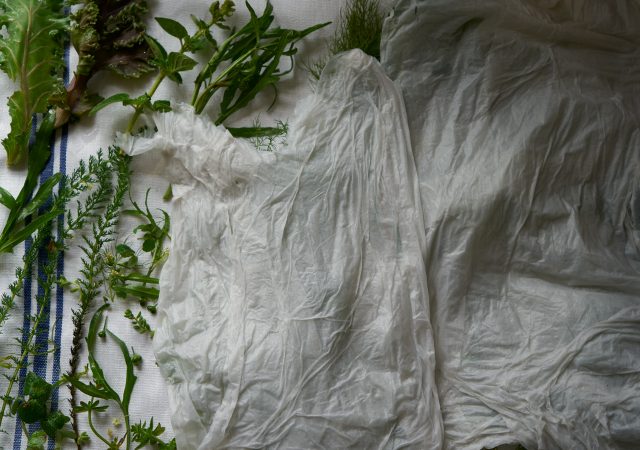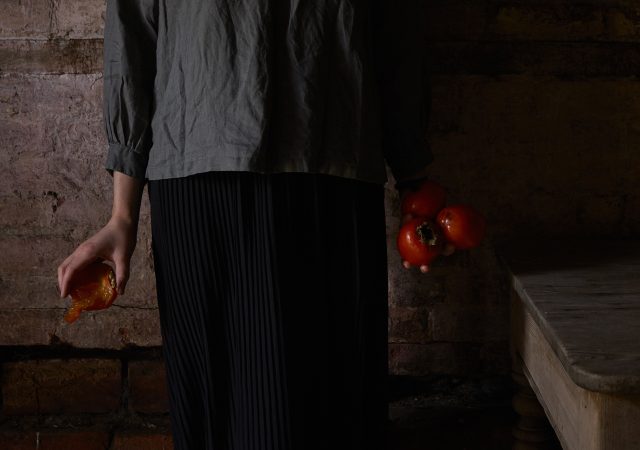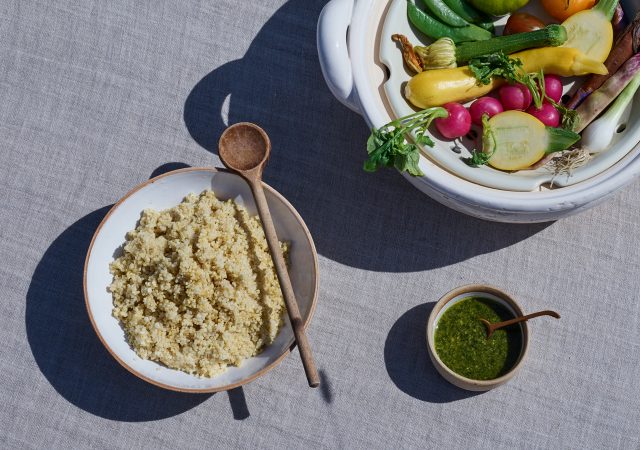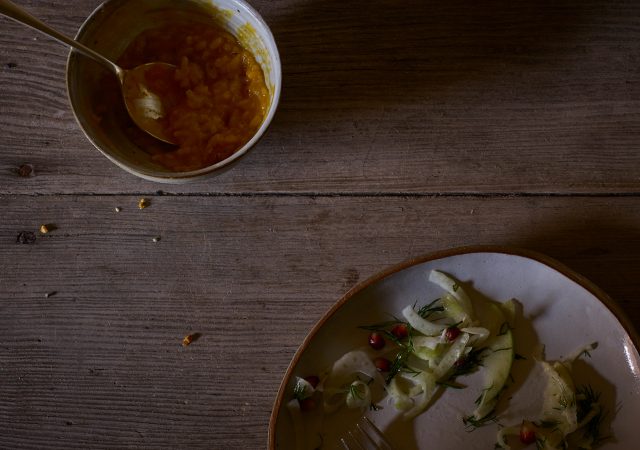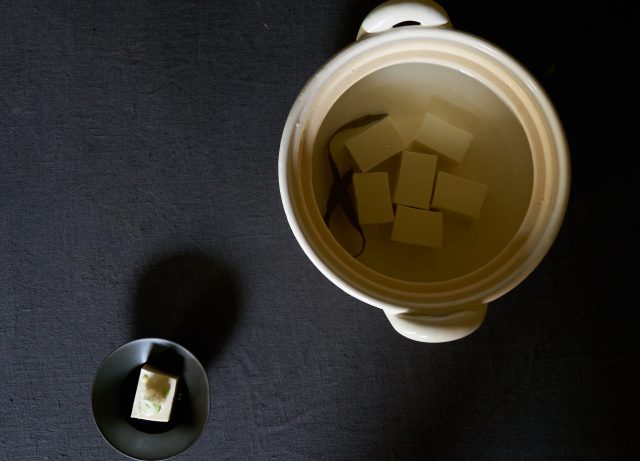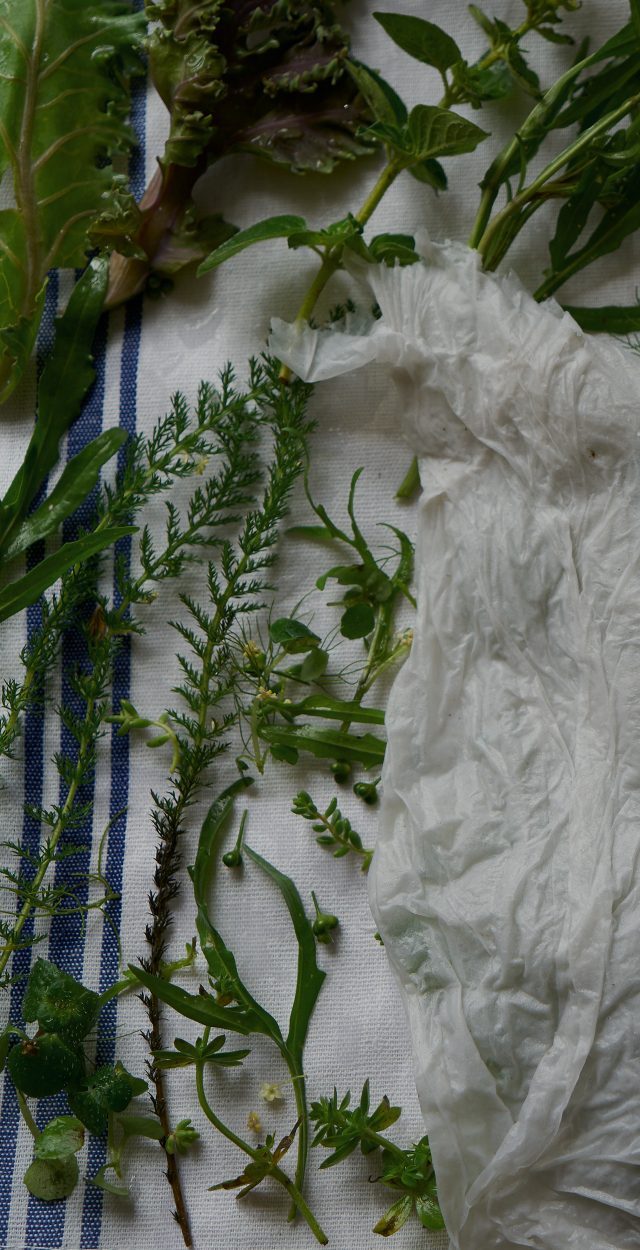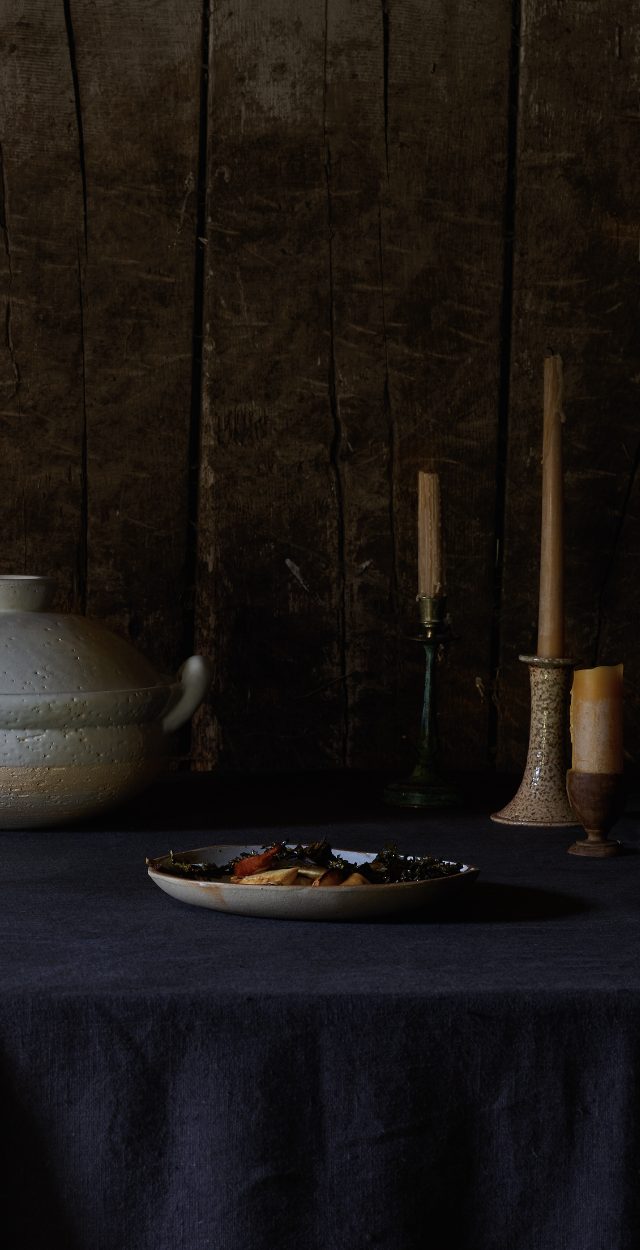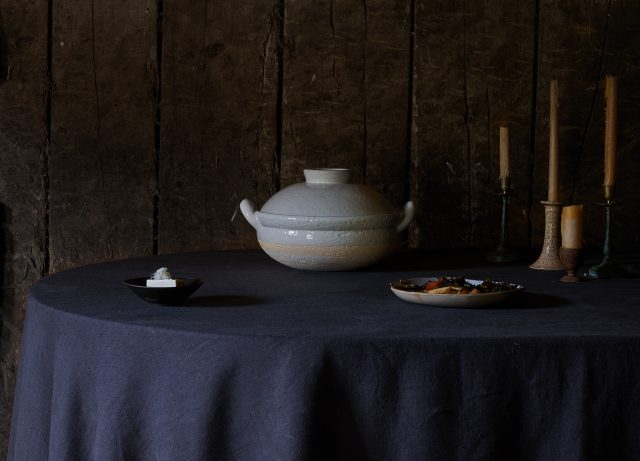
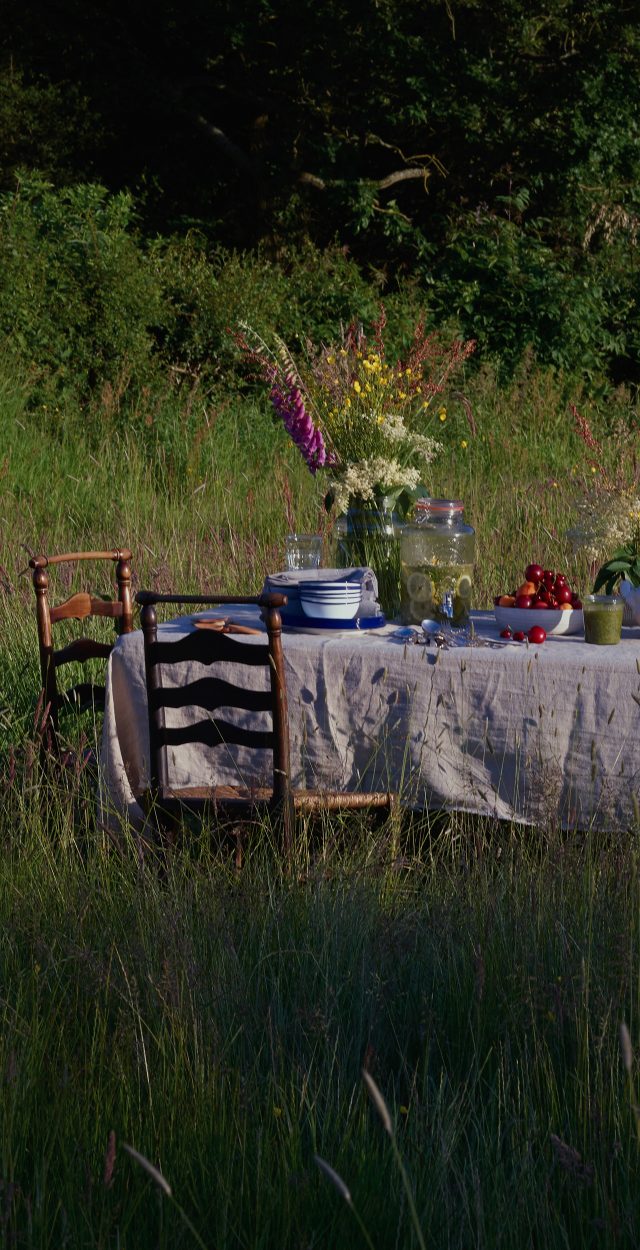
Seasons of the Monastic Table
Inspired by monastic cuisine, this cookbook honors the seasons with twenty-eight recipes to celebrate spring, summer, autumn, and winter.
-
Introduction
“Remember the earth whose skin you are,” writes Joy Harjo, and there is literal truth to this. We are grown from the body of the Earth, we are made of it, and to it we return. Plants, bacteria, animals, fungi, humans: we all exist in relationship to each other and to a rotating and orbiting planet whose journey around the sun gives us waxing and waning light, seed sprouts and withering stems. Being attentive to these cycles and patterns can be a practice of remembrance.
-
Before You Begin
Whatever you decide to cook, give yourself enough time to be attentive to the process. Don’t let a tight schedule discourage you. The purpose is not to demonstrate your cooking skills but to gather around the table. A bowl of spaghetti dressed with garlic and olive oil would be occasion enough to invite friends over for dinner.
-
-
-
-
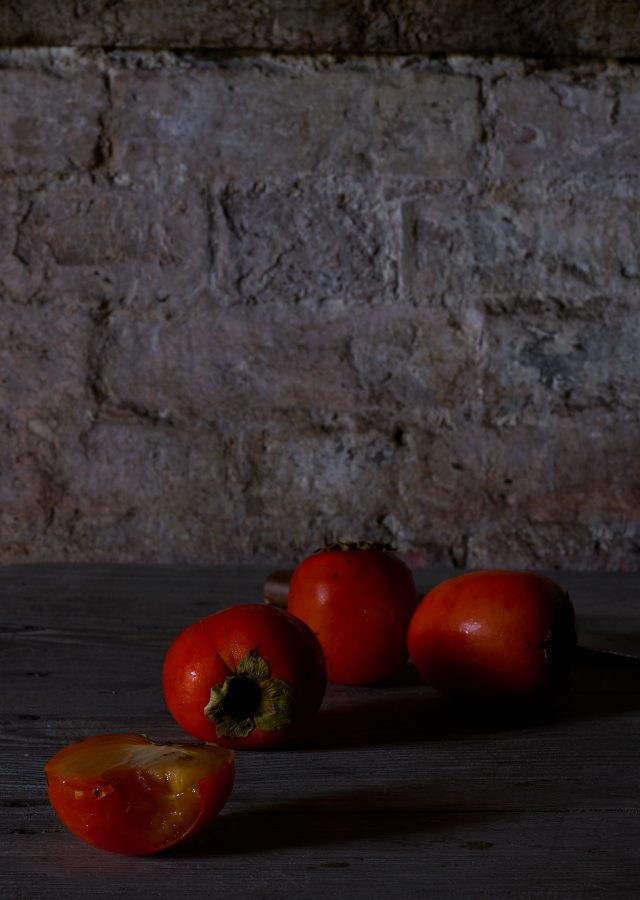

Whatever you decide to cook, give yourself enough time to be attentive to the process.
Don’t let a tight schedule discourage you. The purpose is not to demonstrate your cooking skills but to gather around the table. A bowl of spaghetti dressed with garlic and olive oil would be occasion enough to invite friends over for dinner. Here are a few other things to consider:
· These menus focus on plant-based ingredients, but you might prefer to add or substitute eggs, dairy, or meat.
· When working with these menus, you might choose to select only a couple of recipes or to replace them entirely with your own.
· When you’re ready to cook, have all of your ingredients and equipment in place and enough empty workspace. Cook slowly and attentively, and don’t be afraid to ask your friends or family for help.
· When and if possible, we encourage you to source ingredients locally and organically. This not only supports your community and tends to be more Earth-friendly, but also helps you get to know where your food comes from and what is growing and available around you.
· The recipes here serve six, but you can of course adjust them based on your number of guests.
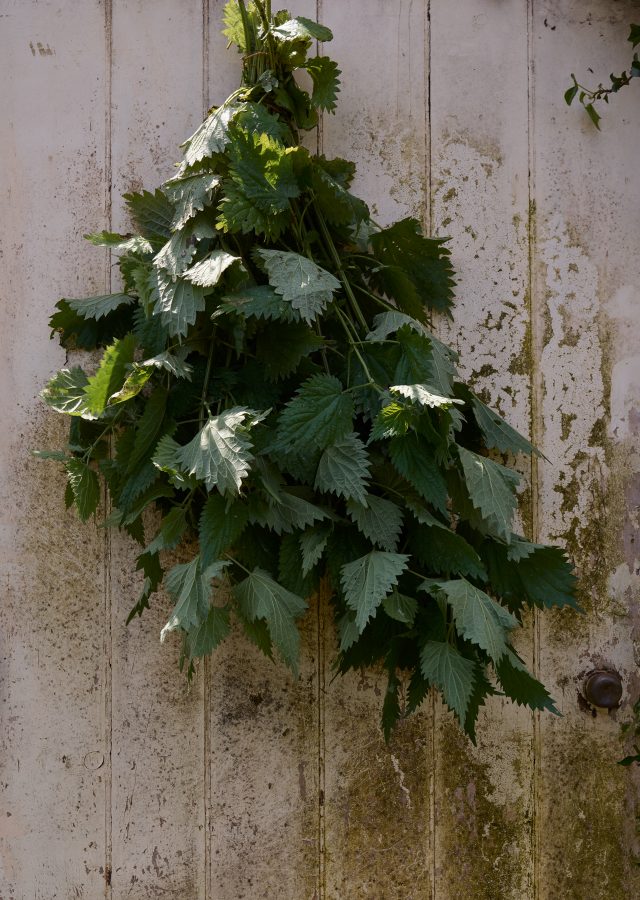
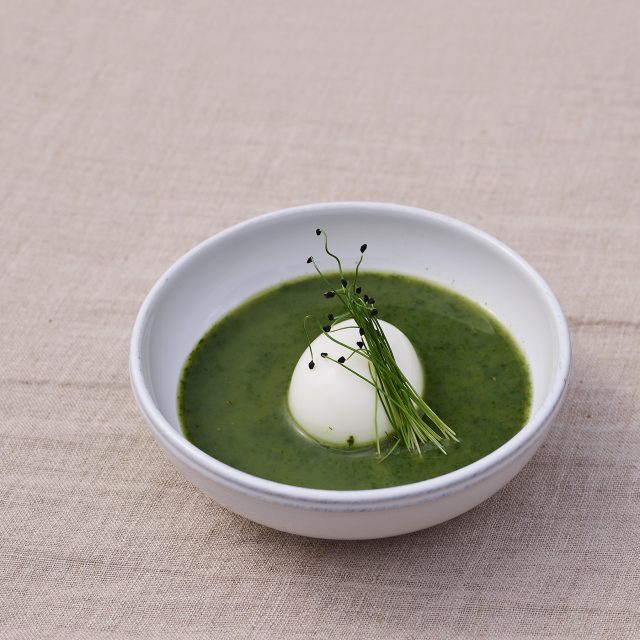
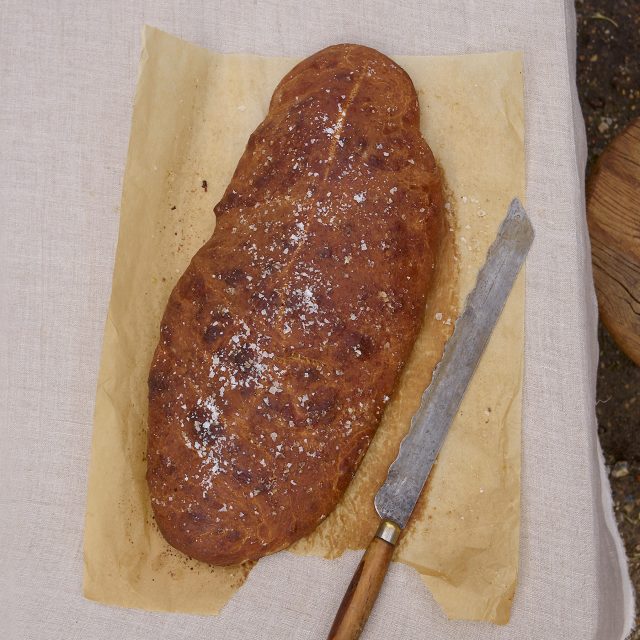
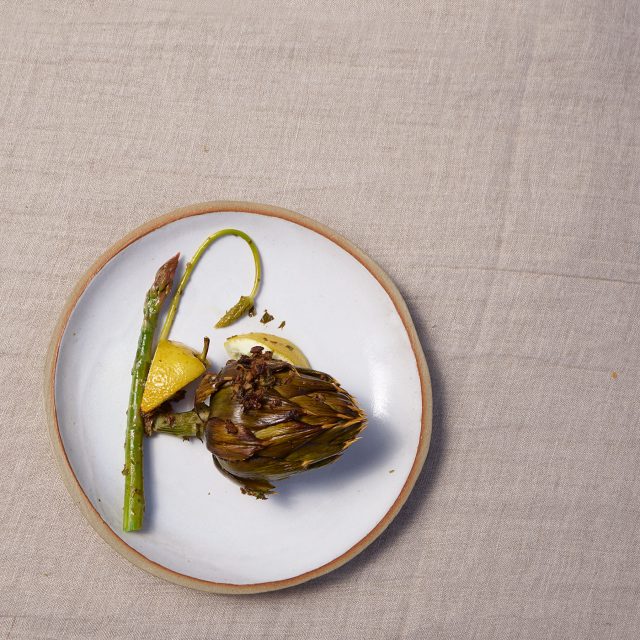
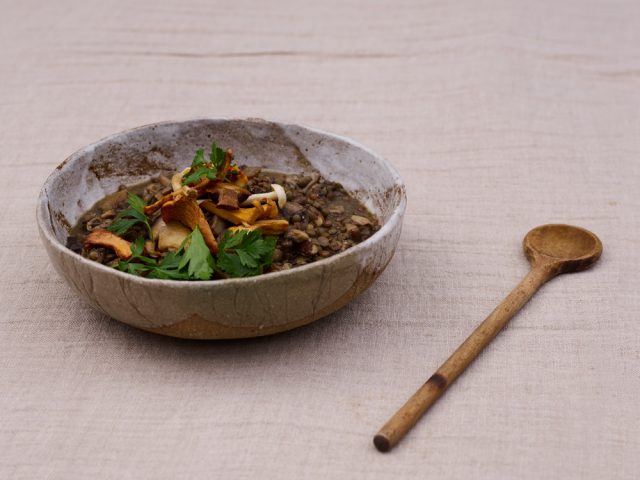
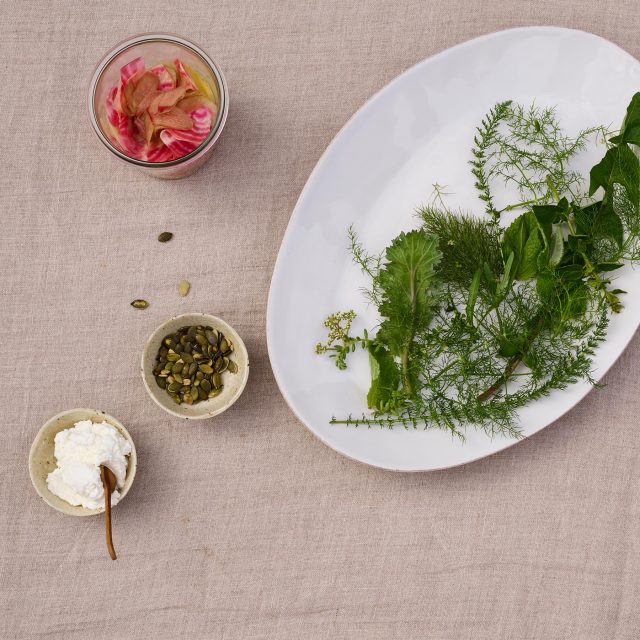

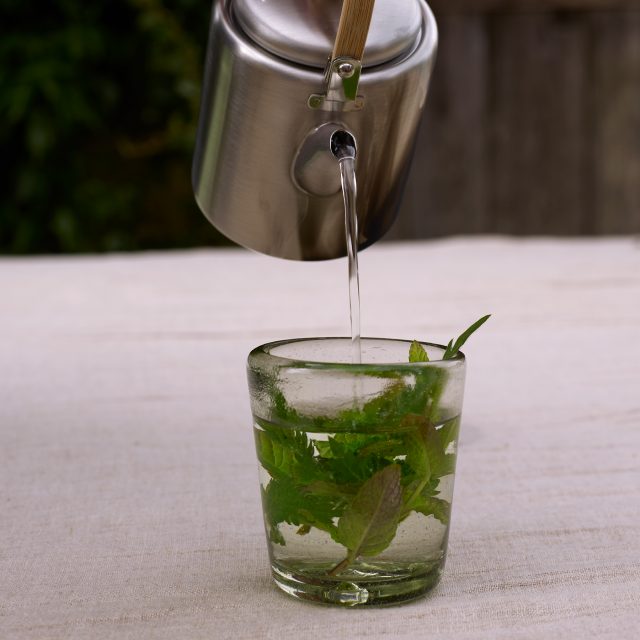
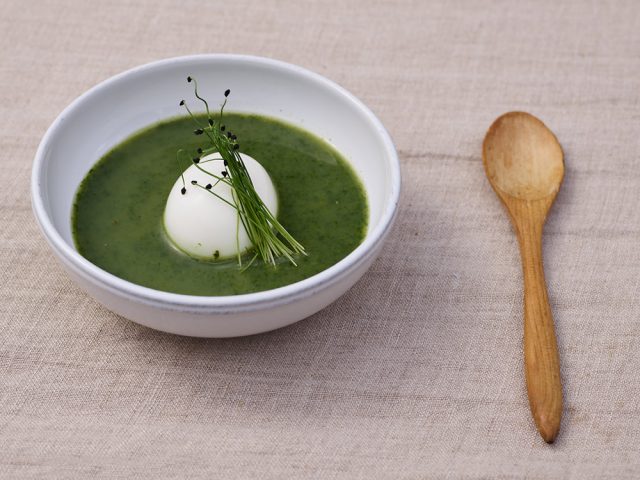
Nettle Soup with Egg or Tofu
Nettles appear in early spring, green and vibrant. These perennials have long been cultivated for their medicinal properties. Most parts of the plant are edible, but the leaves in particular are nutritious and sweet if collected before the nettle has gone to seed.
Ingredients
For the soup
-
6 pints (3 liters) nettles (half a basket or carrier bag)
-
½ cup (100 milliliters) cold water
-
3 tablespoons flour
-
6½ cups (1.5 liters) light vegetable stock
-
Freshly ground nutmeg
-
Sea salt
-
Black pepper
-
Lemon juice
-
Milk of your choice (optional)
To serve
-
1 boiled egg or 2 ounces (50 grams) silken tofu per guest
-
Herbs, wild or locally grown (such as chives or sorrel)
Preparation
Harvest the nettles
With a pair of gloves, scissors, and a basket or bag, go out in search of spring nettles. These hardy weeds grow in most places around the world. Their toothed leaves grow in opposite pairs along a fuzzy stem, making them easy to identify. Look for them along rivers, the edges of fields, hedgerows, or roadside ditches.
This plant earned the name “stinging nettle” for a reason. While there are ways of picking them barehanded, we recommend gloves for the beginner. A pair of gardening gloves will work, or you can use canvas or rubber gloves to avoid being stung.
Only harvest young nettles that have not yet gone to seed. Cut the stem below the top two or three pairs of leaves and place the clipping in your basket or bag. This helps keep the plant alive and healthy (and the top is also the tastiest part).
If you can’t go foraging, you can substitute with spinach, chard, or any other greens.
Prepare the soup
Place the nettles in the sink or a large bowl. Cover them with water and stir gently to clean the leaves. Using gloves and scissors, separate the leaves from the stems, placing the leaves in a large colander.
Set aside a few leaves for the nettle and mint tea.
In a large pot, bring water and a few pinches of sea salt to a boil. Add the nettle leaves. Blanch them for 5 minutes and then transfer them to a bowl filled with ice water. (Note: they will no longer sting you!) Save the nettle water, as you can add it to the stock.
With your hands, carefully squeeze the excess water from the leaves. Chop them as finely as you can, until they form a thick emerald paste. This will take 8–10 minutes.
Add ½ cup (100 milliliters) cold water to a large pot, and whisk in 3 tablespoons of flour. Add a little stock and cook for 1 minute over medium heat, until thickened. Continue to add remaining stock until the soup has a velvety texture. Bring to a boil and add the chopped nettles. While stirring, add freshly ground nutmeg, sea salt, black pepper, and lemon juice to taste. If you want a milder and creamier soup, you can finish with a drizzle of milk of your choice.
Boil the eggs for 5–6 minutes (they should still be soft in the center). Run cool water over the eggs to make them easier to peel. If you opt for tofu, cut one large cube per person. Place one peeled egg or one cube of tofu into small individual bowls, pour the soup over, and serve topped with fresh herbs.

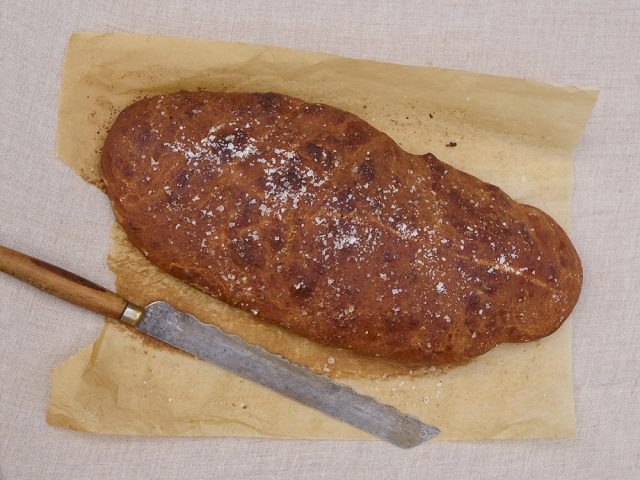
Sleepy Spelt Bread
Bread, in all of its forms, is arguably humanity’s most important and ubiquitous food. It has been a dietary staple since people began cultivating wheat in the Fertile Crescent, around ten thousand years ago.
Spelt is an ancient grain of the farro family and one of the first varieties of wheat to be used in bread baking. It is rich in flavor and produces a bread that is both light and nutritious.
Ingredients
-
¼ ounce (8 grams) fresh yeast (if using dry yeast, use half this amount)
-
1–2 teaspoons fine sea salt
-
1 tablespoon honey (optional)
-
2 cups (500 milliliters) cold water
-
Olive oil (optional)
-
20 ounces (550 grams) white spelt flour or white flour and 5¼ ounces (150 grams) whole-grain spelt flour
-
Sea salt flakes to sprinkle
Preparation
Prepare the dough
Cold fermentation is a baking method in which you leave the dough overnight to ferment at a cool temperature. By allowing the dough to rise slowly, the flavors of the bread become richer and more complex. You can use any flour you prefer in this recipe.
Crumble the yeast in a large, steady baking bowl. Add the salt and honey, and a few drops of water. Stir until the yeast is dissolved. Add the rest of the water and a drizzle of oil.
Add the flour little by little, stirring until you have a loose dough. Stir for another minute or two once all the flour has been added.
Sprinkle some flour on top, cover the bowl with a tea towel, and let it rest at room temperature overnight (or for 8–10 hours).
Bake the bread
Place the dough on a clean surface that has been sprinkled with flour. Turn the dough around a few times, stretching and folding it. Add more flour if it starts to stick.
On a baking tray, shape the dough into a loaf, or simply let the bread shape itself into any form it wants. Sprinkle some flour on top and cover the dough with a tea towel.
Let it rest for 30 minutes. In the meantime, preheat the oven to 480°F (250°C). Place a second tray or oven dish on the bottom rack.
After 30 minutes, drizzle a little oil on top of the dough, sprinkle with sea salt flakes, and put it in the oven. Place an ice cube on the tray on the bottom rack—this will create steam and give your bread a lovely crust.
Check the bread after 15 minutes and lower the temperature if the loaf is already starting to look brown. Bake for 30–40 minutes until golden-brown.
Let the bread cool a little. Slice and serve with olive oil or butter, and sea salt.


Lemon-Roasted Artichoke and Asparagus
Native to the Mediterranean, the artichoke is a perennial and a member of the aster family. Though it’s often served as a vegetable, an artichoke is actually the unbloomed flower of the plant. It’s believed that monasteries played a large part in ensuring the continued cultivation of artichokes after the fall of Rome.
Ingredients
-
1 bunch of asparagus (or other seasonal vegetables)
-
1–2 artichokes per guest
-
1 bunch of flat-leaf parsley
-
1 bunch of rosemary
-
Capers and a handful of green olives
-
1 lemon
-
Olive oil
-
Sea salt flakes
-
⅔ cup (150 milliliters) white wine
Preparation
Rinse the asparagus and snap off the woody portion of the stem (it will naturally break off at just the right point). Rinse the artichokes. You may wish to trim off the spiny tips of the leaves.
Pre-boil the artichokes in salted water for 15–30 minutes, depending on size, until nearly done.
Preheat the oven to 350°F (180°C).
On a large cutting board, chop the parsley and rosemary together with the capers and green olives. Set the mixture aside in a bowl.
Chop a lemon into large chunks. Place the artichokes and asparagus into a deep oven dish and brush them with olive oil. Add the herb-olive mixture, chopped lemon, sea salt flakes, and wine to the dish.
Roast for 15 minutes, until all vegetables are soft but not overcooked. Serve directly from the dish.


Warm Miso Lentils with Mushrooms
Miso—fermented bean paste—can be traced back to the fourth century BC in China and is believed to have been introduced to Japan by Buddhist monks in the seventh century. Miso remains a culinary staple in Buddhist monasteries and in Japanese cuisine more broadly.
In addition to its strong umami flavor, miso is also high in protein and rich in vitamins. As a fermented food, it provides the gut with healthy bacteria.
Ingredients
-
1 cup lentils (dark speckled, black, or brown)
-
¾ ounces (20 grams) dried mushrooms (wild if possible)
-
7 ounces (200 grams) fresh mixed mushrooms
-
Oil or butter
-
A generous dash of white wine or lemon
-
Soy sauce or tamari to taste
-
Black pepper
-
1–2 tablespoons miso paste
-
A small bunch of fresh parsley
Preparation
Place the lentils and dried mushrooms into separate bowls. Fill each with water and soak overnight.
In the morning, drain and rinse the lentils. Drain the mushrooms, but retain the soaking water to use as broth.
In a pot, combine the lentils with the mushroom broth, plus additional salted water as needed. (For 1 cup of lentils, you will need 3 cups of liquid in total.) Bring to a boil, cover, and simmer for 15–20 minutes, until tender.
Chop the soaked mushrooms into small pieces.
Clean and trim the fresh mushrooms, and tear or slice them into uneven, large chunks. Keep some of the fresh mushrooms whole and cook them separately to garnish the dish.
Heat oil or butter in a pan and sauté the mushrooms. When they’ve just begun to soften, add the white wine, soy sauce, and black pepper to taste. Cook them until soft and golden brown. Set aside.
When the lentils are done, drain them if needed but keep the broth. (You can add several spoonfuls of broth when serving to ensure the dish is moist.) Add most of the mushrooms, and stir in a spoon or two of miso paste. For a milder miso flavor, try white or yellow miso.
Serve warm in a bowl and top with the remaining mushrooms and parsley leaves.


Pickled Beet and Rhubarb Salad
Though pickles are a modern staple in kitchens the world over, this ancient practice of preserving food with vinegar or brine dates back to at least 2400 BC. In some monasteries, pickling provides not only practical and health benefits, but also carries symbolic value. “As the brine works its magic with the cucumber, prayer and daily living works its magic for each community member,” writes Sister Lisa Rose, a nun at St. Benedict’s Monastery in Minnesota.
Ingredients
For the pickling
-
4 medium beets (preferably chioggia and/or golden)
-
1–2 rhubarb stalks
-
½ lemon
-
¼ cup apple cider vinegar
-
1 tablespoon finely grated ginger
-
Sea salt flakes
-
Honey, or plant-based option to taste
To serve
-
Seasonal lettuce leaves
-
Toasted pumpkin seeds, hazelnuts, or alternative
-
Goat’s or sheep’s curd (optional)
Preparation
Pickle the beet and rhubarb
Peel the beets and slice as finely as you can, using a mandoline or a peeler. Ideally, they should be about 2 millimeters thick.
With a sharp knife, slice the rhubarb diagonally into thin slices.
Add beets and rhubarb to a bowl and toss with lemon juice, apple cider vinegar, finely grated ginger, sea salt flakes, and a generous spoonful of honey. Taste and adjust the flavor to your liking. Put the mixture into a glass jar with a lid (or another airtight container) and leave it in the fridge. If you wish, you can do this step on the day before.
To serve
Wash the lettuce and pat dry with a tea towel or dry in a salad spinner. Arrange the whole lettuce leaves on a large platter.
Toast the pumpkin seeds in a pan and set aside.
Serve the beets on the large platter, and arrange all the ingredients together over the lettuce. To serve the beets directly from the jar, place the pumpkin seeds, lettuce leaves, and any other additions in their own bowls so guests can compose their own salad.
If you want to add something extra, goat’s or sheep’s curd, or goat cheese, goes wonderfully with this salad.

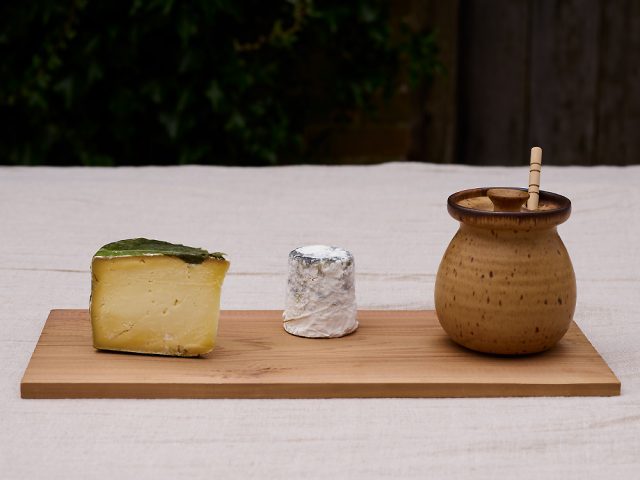
Cheese and Honey
Humans have lived in relationship to honey bees and have enjoyed honey in our diet since the days of hunting and gathering. We’ve been making cheese for at least 7,500 years and written records show that we’ve been combining cheese and honey since ancient Greece.
Beekeeping and cheesemaking became fixtures of monastic life during the Middle Ages in Europe. Today, many monasteries still produce their own cheeses, or keep bees that produce honey and beeswax.
Ingredients
-
Cheese (We recommend a combination of soft and hard cheeses, made from cow, sheep, or goat’s milk.)
-
Honey
Preparation
Either serve the cheese and honey from a shared platter, or cut a slice of cheese for each guest and serve it on a small plate, accompanied by honey in a teaspoon. A slice of the Sleepy Spelt Bread will go well with this.

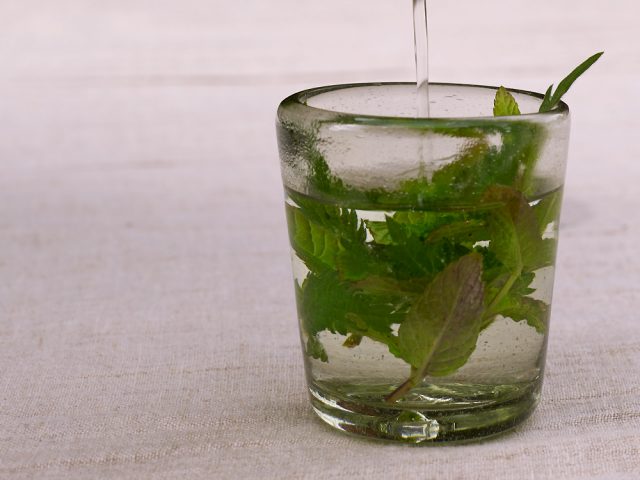
Nettle and Mint Tea
A basic premise of cooking at monasteries is to use what you have and to reuse leftover ingredients.
This calming after-dinner tea combines leftover nettle leaves from the soup with the soothing and digestive properties of mint.
Ingredients
-
Fresh nettle leaves
-
1 bunch of mint leaves
Preparation
In a teapot or in individual cups or glasses, pour hot water over fresh nettle and mint leaves. Let steep for at least 5 minutes before serving.


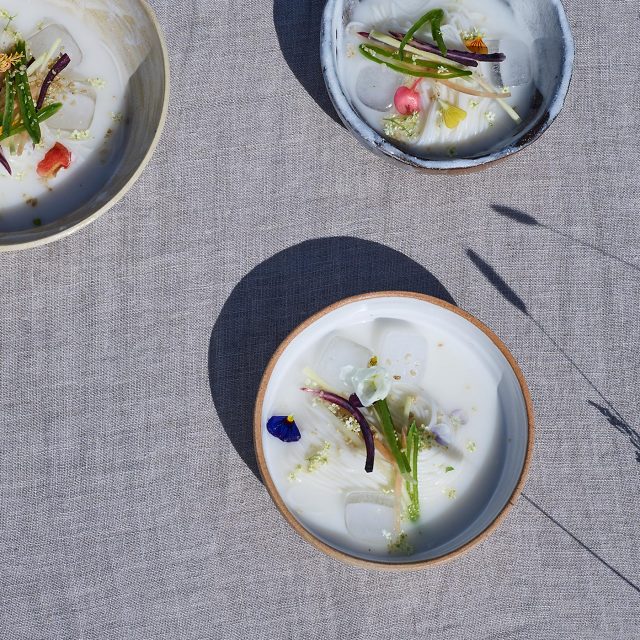
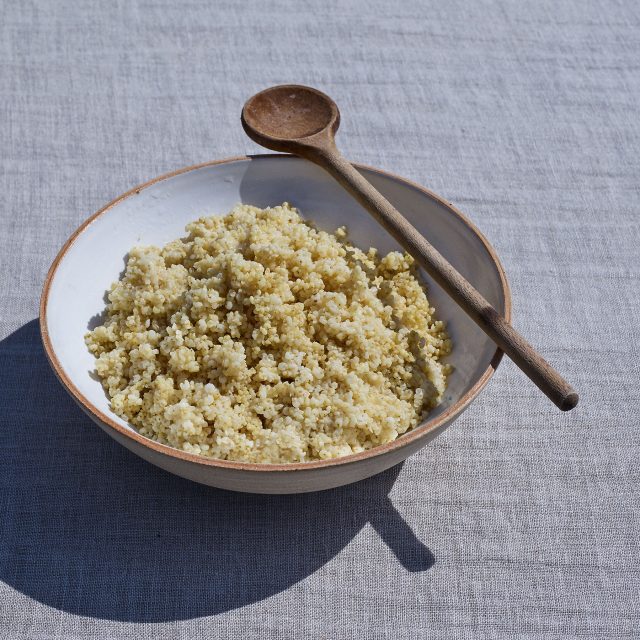
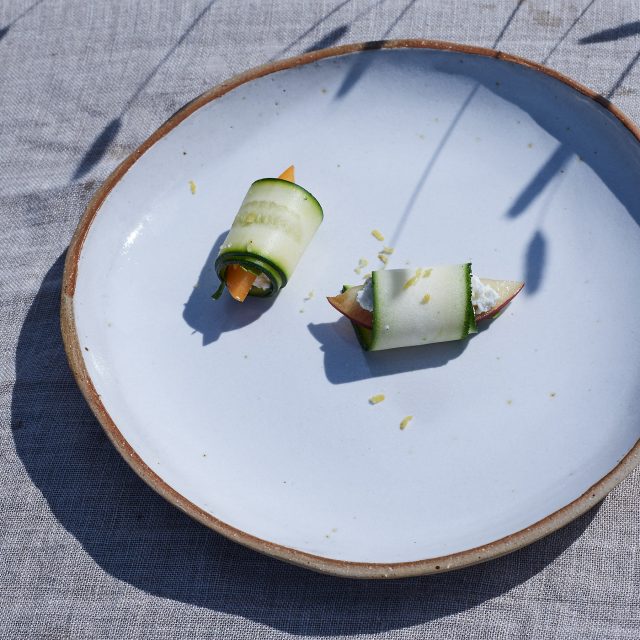
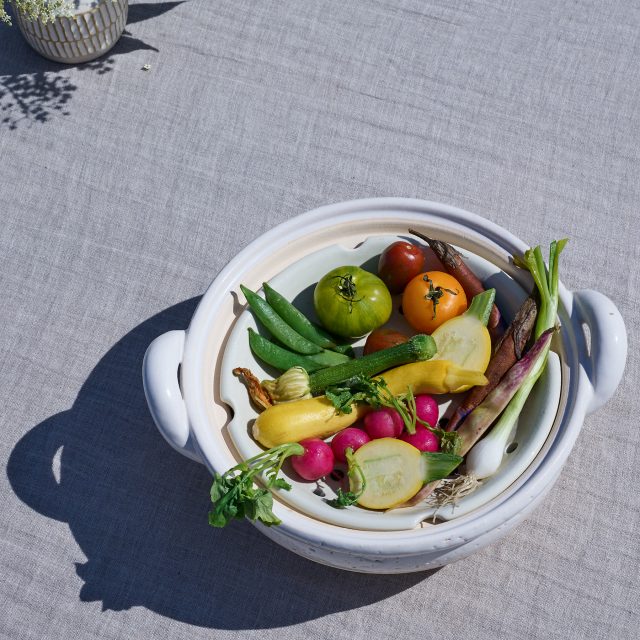

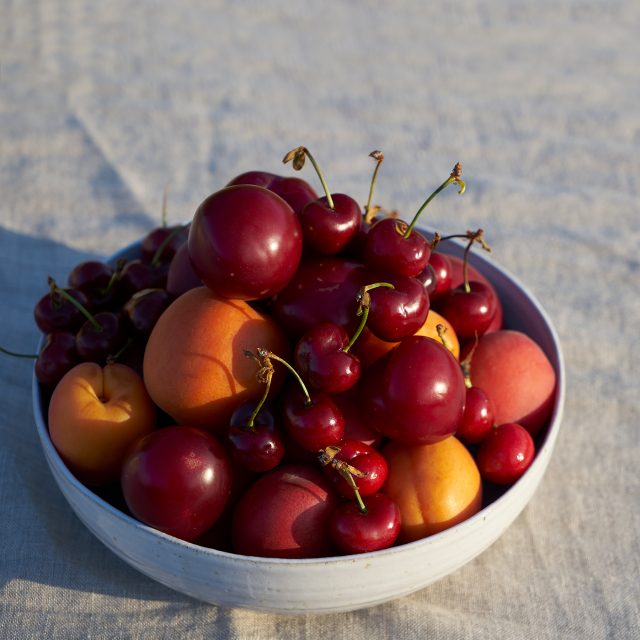
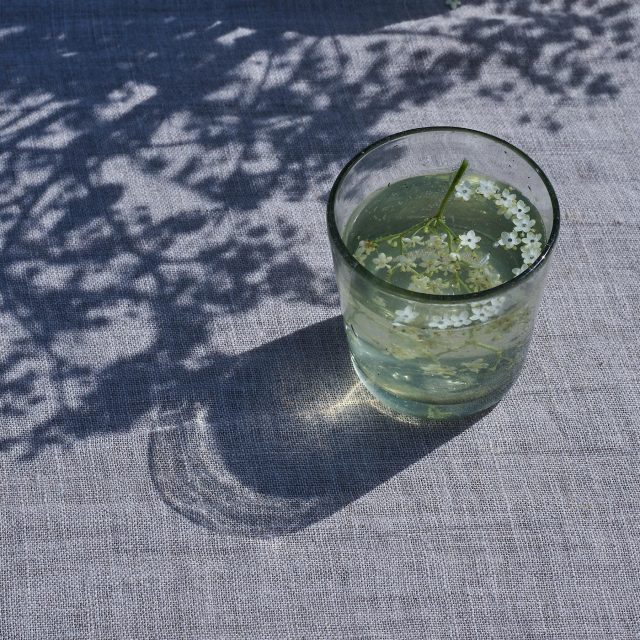
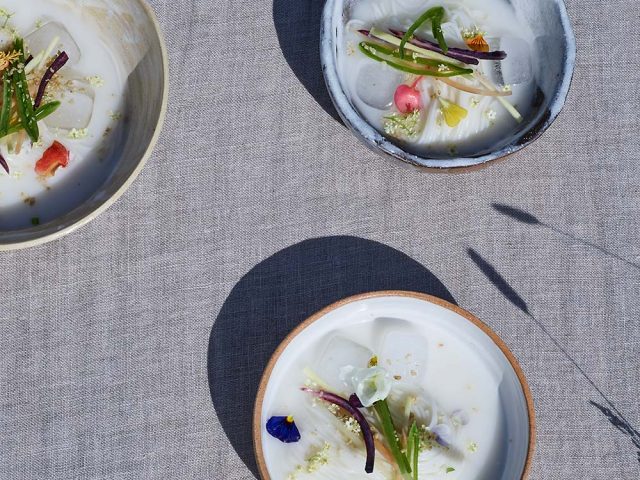
Iced Meadow Soup
This recipe invites you to make your own soy milk as the liquid base for a chilled summer soup.
Beans—and soybeans in particular—feature widely in temple cuisine at Buddhist monasteries in Japan and Korea as an important source of protein in a vegetarian or vegan diet. The soybean was domesticated by farmers in China thousands of years ago. Today they are used to make many vegetarian staples, including tofu, tempeh, and miso.
Iced noodle soup is a seasonal favorite in Japan. Garnished with fresh flowers and crisp vegetables, this dish is an embodiment of early summer—bright, delicate, and colorful.
Ingredients
Ingredients
-
½ cup soybeans or 6½ cups (1.5 liters) soy milk or other plant-based milk
-
2 ounces (50 grams) pine nuts and/or sesame seeds
-
Sea salt flakes
-
Honey
-
1 tablespoon nutritional yeast (optional)
-
A handful of edible flowers
-
Seasonal crispy vegetables, such as sugar snap peas, fennel, or pink beet
-
7 ounces (200 grams) somen wheat noodles or thin buckwheat noodles
-
A few ice cubes per guest
Preparation
Make the soy milk
To make your own soy milk, first soak the soybeans overnight. In a pot, bring water to a boil and add the beans. Cook for 20–30 minutes until soft, and rinse with cold water. Taking a few minutes to shell the cooked soybeans will make the milk taste even better, but isn’t necessary.
Toast the pine nuts or sesame seeds in a pan. Add the soybeans to a blender with 1 quart (1 liter) water, half of the pine nuts or sesame seeds, a pinch of sea salt, and a small spoon of honey. Blend until creamy and strain if you wish.
Prepare the topping
Using a mortar and pestle, grind the remaining pine nuts or sesame seeds with a generous amount of sea salt and a little nutritional yeast.
Prepare the edible flowers
Wash the whole flowers or individual petals in a large bowl of cold water and let them air dry on a tea towel. Line an airtight container with damp paper towel and store them in the fridge until serving.
Prepare the crispy vegetables
Trim and slice the sugar snap peas lengthwise or simply open them up in halves. Slice the pink beet very thinly and then cut into thin vertical strips.
To serve
Bring a large pot of salted water to a boil, and cook the noodles for 3 minutes, or according to the instructions.
Strain and rinse the noodles with cold water until chilled. Gently squeeze out any excess water and place the noodles in six individual bowls.
Stir or shake the soy milk to make sure it’s well-combined. Pour the milk over the noodles. Add the ice cubes just before serving. Top the soup with peas, beets, the pine nut mixture, and the flowers. We recommend eating this dish with chopsticks.

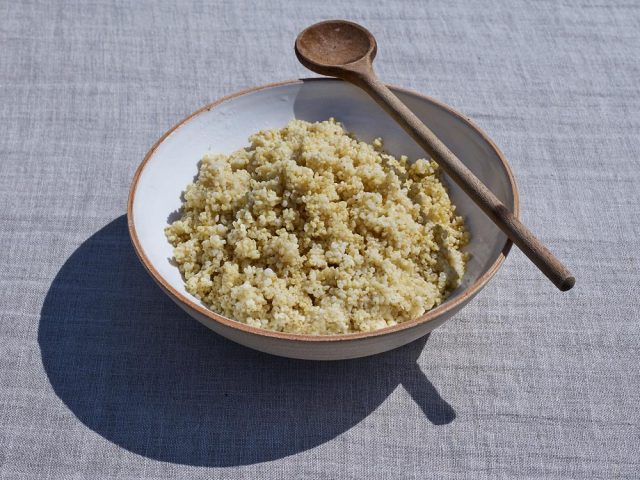
Millet
Like wheat, millet is an annual cereal grass, grown for its edible seeds. The five primary species of millet cultivated around the world today are: proso, foxtail, barnyard, browntop, and pearl. This dressed-down dish highlights the natural flavor of this ancient grain, which needs very little added to it to be delicious.
Ingredients
-
2 cups whole-grain millet or local grain
-
4 cups boiling water
-
Sea salt
Preparation
In a pot over medium heat, toast the millet until golden brown.
Add the boiling water and sea salt. Reduce the heat, cover, and let simmer for 15 minutes. Remove from heat and let the millet rest for 10 minutes, still covered. Fluff it with a fork before serving.


Zucchini Summer Rolls
For the novice gardener, planting zucchini is a great vegetable to begin with. This summer squash embodies the effortless abundance of the season: it is low-maintenance and prolific, producing a steady supply of fruit throughout the growing season.
Ingredients
-
1 unwaxed lemon
-
Soft cheese (such as goat/sheep), plant-based cheese, or blended firm tofu
-
Honey or plant-based option
-
Sea salt flakes
-
Black pepper
-
1 bunch of fresh mint
-
1 bunch of pea shoots
-
1–2 medium zucchini/courgettes
-
A peach or nectarine
Preparation
Wash the lemon. Use a grater to remove the zest.
In a bowl, mix the cheese with honey, a small pinch of sea salt, black pepper, and most of the lemon zest.
Wash, dry, and trim the mint and shoots. If the stems are not too thick and woody, include them as well. Keep shoots and any soft stems a little longer than the width of the zucchini slices. If you prepare these steps in advance, put the zest and herbs in separate airtight containers that are lined with a damp paper towel and store in the fridge.
With a peeler or mandoline, slice the zucchini lengthwise, as thinly as possible. Cut the peach in very thin wedges.
Assemble the rolls just before serving. Spread the cheese mixture onto the zucchini slices, add peach, mint, and shoots so that they stick out on the sides. Roll up and place on a platter. Sprinkle them with lemon zest.


Lightly Steamed Garden Vegetables
Salads at a Benedictine monastery in Italy can be as simple as a bowl of plain lettuce or an unsliced cucumber. Indeed, the abundance of a summer garden can make things rather easy on the chef. Fresh vegetables need little prepping and cooking to be sweet in flavor and beautifully presented.
Ingredients
-
Summer vegetables, such as zucchini, cherry tomatoes, okra, sugar snap peas, new potatoes, and wax beans
-
Sea salt
Preparation
Wash the vegetables. Use a root vegetable brush or peeler if necessary, or leave the peel on and let them dry on a tea towel.
Keep the small vegetables (such as beans and peas) whole, and cut the larger ones in halves, quarters, or irregular chunks.
Bring a little water to a boil, and arrange the vegetables in a steamer basket or pot. When combining different vegetables, you might want to add those with a shorter cooking time towards the end, such as the sugar snap peas or tomatoes. Cook them until tender but not too soft. Serve them directly from the basket, or on a platter or bowl, along with the pesto and millet. Add sea salt to taste.

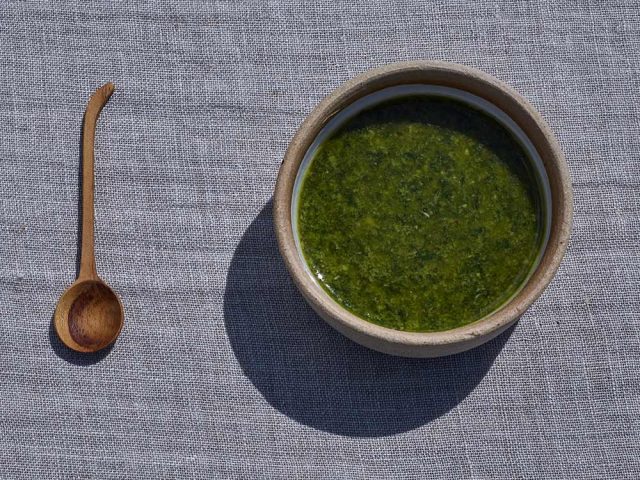
Mint Pesto
“Pesto” comes from the Italian pestare, to pound or to crush. Though it is well-understood that this sauce originated in Italy, the story of its invention is left to legend. Some say a monk from the convent of Saint Basil harvested this herb from the hillsides and combined it with ingredients donated from the community. Others say sailors in Genoa would crush basil to better preserve it, allowing them to enjoy the flavor of home on long journeys.
Ingredients
-
1 ounce (25 grams) pine nuts, or other nuts or seeds to your liking
-
1–2 garlic cloves
-
A generous bunch of fresh basil
-
A generous bunch of fresh mint
-
½ cup parmesan cheese, or nutritional yeast
-
Sea salt
-
Black pepper
-
A dash of lemon
-
A generous amount of olive oil
Preparation
Toast the pine nuts (or other nuts or seeds).
Combine pine nuts, garlic, basil, mint, finely grated cheese, sea salt, black pepper, and a little lemon juice and grind them together with a mortar and pestle, adding a little olive oil at a time until smooth and runny.
You can also use a blender or a food processor.

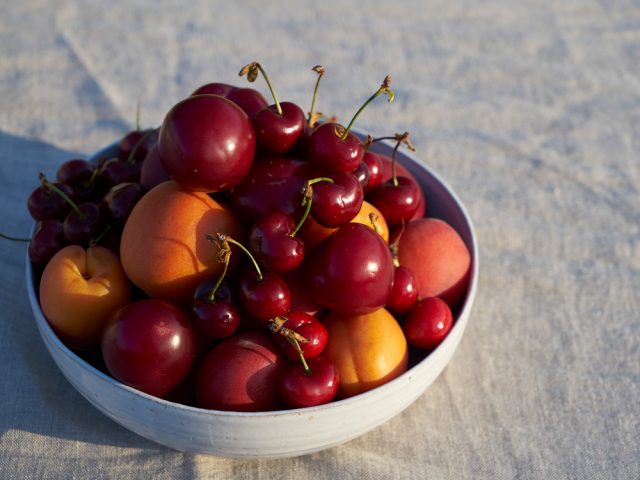
Summer Fruits
This dish perhaps best embodies the celebratory nature of summer: the season itself has prepared this colorful feast. All that is asked of you is the simple joy of the harvest.
Ingredients
-
Plums, nectarines, apricots, peaches, and cherries, or other seasonal fruits or berries
Preparation
Wash and arrange the whole fruits and berries on a simple platter or bowl.


Elderflower and Rosemary Cold Brew
Elderflower is fragrant and sweet, appearing in late spring and early summer: a large blossom composed of splays of tiny white flowers. In the United States, elderflower grows on the American elderberry, or common elder. In the UK, it grows on the elder tree, also known as black elder, ellhorn, pipe tree, and holler.
Elderflower has long been used for its medicinal properties or added to cordials and tonics.
Ingredients
-
15 elderflower sprigs
-
⅔ cup (150 milliliters) sugar or honey
-
Fresh rosemary sprigs or lemon balm
-
1 unwaxed lemon
-
1 tablespoon apple cider vinegar
-
Water
Preparation
Harvest the elderflower
To harvest elderflower, use scissors to cut the flower head where the many small stems meet the main stem, picking only the head of the flower. If possible, try to harvest flowers from a selection of different trees or shrubs (or at least from different places on the same tree), so that some flowers remain that can produce berries to feed birds, insects, and small mammals.
Prepare the cold brew
Shake the elderflowers carefully to remove any insects or dirt. Place the flowers in a large glass jar or bowl. Add the sugar or honey, rosemary, sliced lemons, and apple cider vinegar, and fill the container with water.
Leave the mixture in the fridge. Check on the flowers and give them a gentle stir every morning and evening for two days.
Strain the brew through a sieve or muslin cloth and serve it from a glass jug over ice. If you wish, you can top it up with some sparkling water. Garnish with fresh elderflowers and fresh sprigs of rosemary.


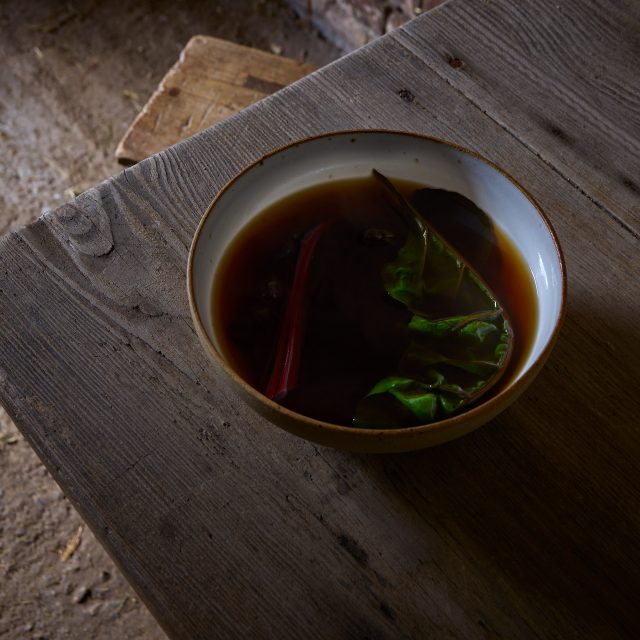

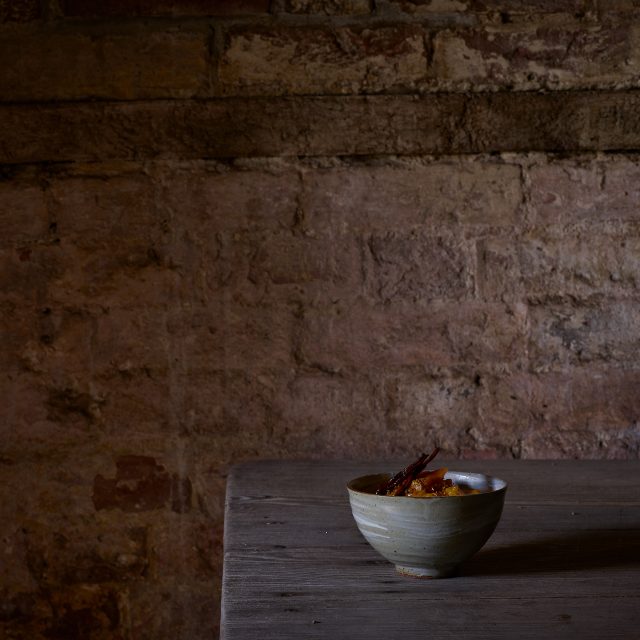
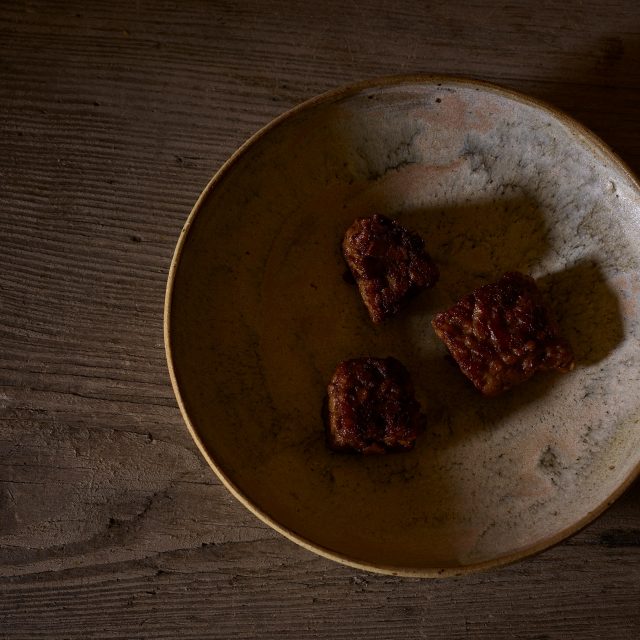
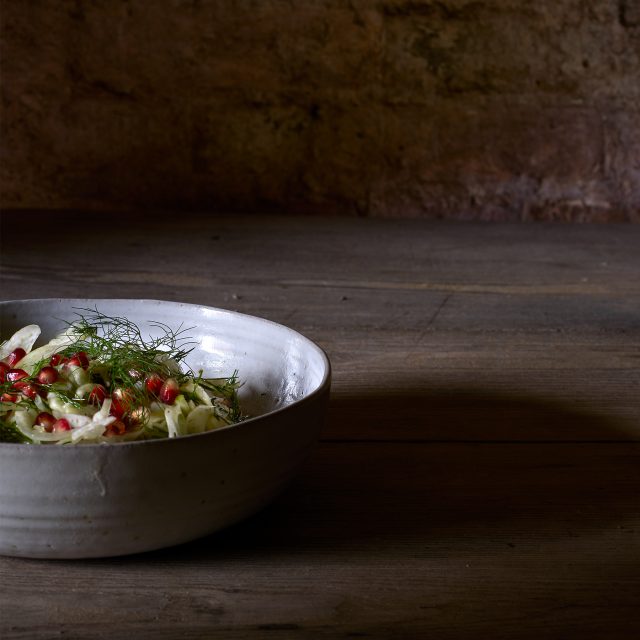

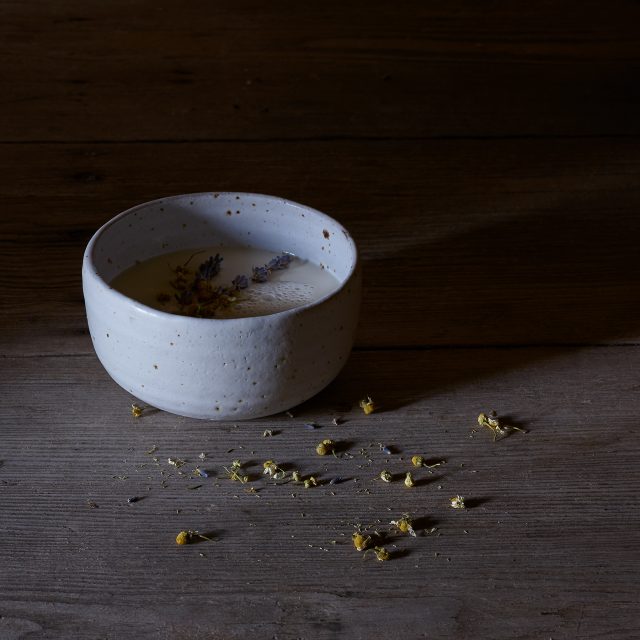

Wilted Leaves in Mushroom and Ginger Broth
This simple and light soup is made of things that form and grow in the darkness and damp of the soil, beneath the surface. Mushrooms, beets, and ginger root combine to give this dish a deeply earthy flavor.
Ingredients
-
1 ounce (30 grams) dried mushrooms
-
A small knob of ginger
-
1 beetroot
-
2 bay leaves
-
Sea salt
-
Seasonal small leaves of spinach or chard, or foraged wild ones
Preparation
In a large pot, soak the mushrooms in 6–8 cups (1.5–2 liters) of water for at least an hour or overnight, until soft.
Peel and slice the ginger. Cut the beetroot into quarters. Add the beetroot, ginger, bay leaves, and some salt to the pot of mushrooms and the water they’ve soaked in. Bring to a boil and let simmer for 30 minutes. Remove any foam. Taste the broth and add salt or more water to taste.
Strain the broth. (Note: you can save the mushrooms and beets to reuse in other cooking.)
Wash and dry the seasonal leaves. Submerge them in the broth and cook for about 4–5 minutes, until soft. Serve the broth with chopsticks.


Late Sesame Greens
Cited as humanity’s oldest oilseed plant, sesame has a history as both a culinary and a mythic fixture in diverse civilizations and cultures. King Tutankhamen was buried with sesame seeds; Alexander the Great is depicted feeding sesame seeds to birds in the Persian text Iskandarnama (the Book of Alexander); the magical incantation “open sesame” in Ali Baba and the Forty Thieves speaks to the belief that sesame had mystical powers.
Ingredients
-
3 tablespoons sesame seeds, plus more for garnish
-
2 tablespoons sesame oil
-
2 tablespoons neutral oil, such as peanut or safflower
-
1 lemon
-
Sea salt flakes
-
Honey or plant-based option to taste
-
Broccoli and kale or other autumn greens
Preparation
Toast the sesame seeds carefully and then grind them using a mortar and pestle. Whisk together the oils, ground seeds, lemon juice, sea salt, and honey. Taste and adjust to your liking.
Wash the broccoli and kale. Chop or tear both into large pieces. Use the broccoli stem, as it has a lot of flavor.
In a large pot or steamer, bring salted water to a boil. Add the broccoli, reduce the heat, cover, and steam or cook until tender, about 5–7 minutes. After a couple of minutes, add the kale.
Gently mix the warm vegetables with the dressing. Add some extra toasted sesame seeds on top. Serve immediately.


Pumpkin Risotto with Crispy Pumpkin Skin
Full of color and character, winter squash are remarkable. Some varieties are able to be stored for over six months and are an autumn and winter source of potassium, fiber, and vitamins.
Your patient stirring will be worth the effort in this warming dish that pairs sweet and creamy risotto with the salty crunch of crispy pumpkin skin.
Ingredients
-
1 medium-sized winter squash, such as kabocha
-
Olive oil
-
Sea salt flakes
-
1–2 shallots
-
10½ ounces (300 grams) arborio risotto rice or other grains
-
½ cup (100 milliliters) white wine
-
6–8 cups (1.5–2 liters) light vegetable stock
-
Freshly grated parmesan, local hard cheese, or a spoon of nutritional yeast
Preparation
Prepare the squash
Preheat the oven to 320°F (160°C). Wash the squash carefully. Cut in half and roast with the cut-side down for 45–60 minutes, until very soft and releasing liquids.
Remove the seeds and set aside. Scrape the flesh and blend into a purée.
Bake the skin and seeds
Cut or tear the skins in strips and toss with a little olive oil and sea salt flakes.
The seeds don’t need to be entirely clean: it’s fine if there is still some pumpkin flesh around them.
On two baking trays or large oven dishes, roast the seeds and skins separately, at 320°F (160°C). Turn them around every now and then, until the seeds are dry and the skins are crisp. Alternatively, you can dehydrate the skins in the oven or in a dehydrator overnight.
Once dried, chop the pumpkin seeds as finely as you can and combine them with sea salt flakes.
Set the skins aside.
Cook the rice
Chop the shallots, heat a little oil in the pan, and cook them on low-medium temperature until soft but not brown. Add the rice and a little sea salt. Stir well. Let the rice mixture heat up, and then add the wine and let it soak into the rice.
Start adding the vegetable stock, little by little, and stir. When it has disappeared into the rice, add more, stirring frequently. Cook over low-medium heat for 20–30 minutes, until the rice is soft and creamy. The texture should be like porridge.
Fold in the cheese and most of the pumpkin purée, setting some aside for topping.
Serve the risotto warm with a generous dollop of pumpkin purée, the crispy pumpkin skins, and more cheese. Sprinkle the pumpkin seed salt on top along with a drizzle of olive oil.

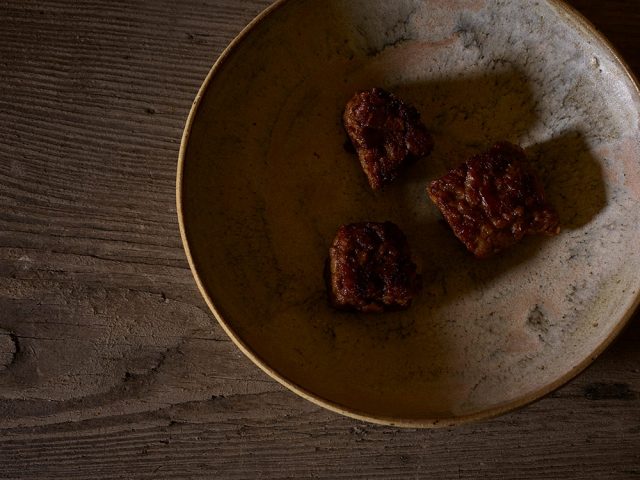
Cinnamon Tempeh
A strict adherence to a vegetarian or vegan diet in Buddhism stems, in part, from the belief that all sentient beings have the possibility of reaching enlightenment. This belief carries the natural consequence of eating mindfully, in awareness of how one’s choices exist in relationship to the greater web of life. Of course, in mainstream secular society, there are also plenty of reasons to be mindful of the source of our protein, especially when it comes from animals.
Tempeh is a plant-based protein made of fermented soy. Mild in flavor, it is ideal for marinating.
Ingredients
-
14 ounces (400 grams) tempeh
For the marinade
-
¼ cup sesame oil
-
¼ cup soy sauce
-
2 tablespoons cinnamon powder
-
A small knob of fresh ginger, finely grated
-
2 tablespoons maple syrup or honey
-
Juice from half a lemon or lime
For baking
-
Neutral oil, like peanut or safflower
-
Extra soy sauce
-
Maple syrup or honey
Preparation
Prepare the marinade
Marinate the tempeh a day or two before your dinner, or a few hours before cooking. To make the marinade, add all ingredients to a bowl and whisk to combine.
Fill a pan or skillet with an inch of water and bring to a boil. Add the tempeh, cover, and reduce the heat. Simmer the tempeh for 5 minutes, flip it, and simmer for another 5 minutes.
Rinse the tempeh with cold water and pat dry. Cut it into bite-sized cubes and toss with the marinade. Leave covered in the fridge for 12–24 hours, turning it occasionally.
Bake the tempeh
Preheat the oven to 375°F (190°C).
Drizzle some neutral oil, extra soy sauce, and maple syrup over the marinated tempeh and turn it several times to make sure it’s coated evenly. Spread out on a baking sheet.
Bake for 20–25 minutes until golden brown and crisp.
Serve hot.

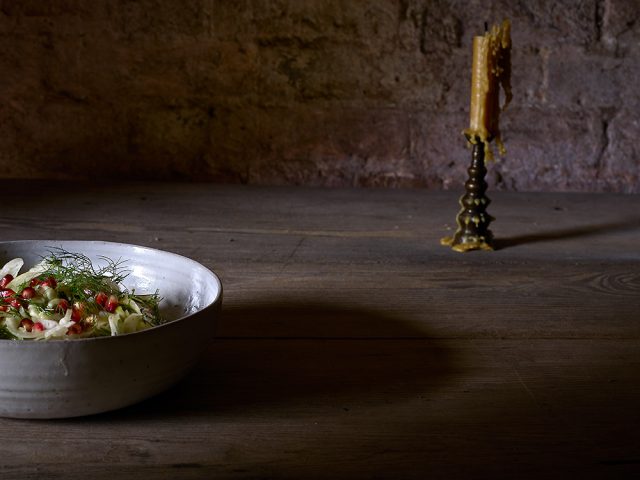
Fennel, Apple, and Pomegranate Salad
The Greek goddess Persephone became trapped in the Underworld after eating the seeds of a pomegranate, but Pluto agreed to allow her to return to the world above for part of each year. Her arrival prompted the return of spring, and the pomegranate became a symbol of awakening and eternal life. Early Christians associated the fruit with resurrection. Pomegranate seeds are eaten during Rosh Hashanah—the Jewish New Year and the first of the high holy days that occur in early autumn—as a symbol of fruitfulness.
This dish is crunchy and full of brightness, highlighting the natural textures, colors, and flavors of raw fennel, apple, and pomegranate.
Ingredients
For the salad
-
½ pomegranate
-
1–2 fennel bulbs
-
1–2 apples
-
1 lemon
-
A few sprigs of dill to garnish
For the dressing
-
¼ cup chopped fresh dill
-
¼ cup olive oil
-
¼ cup apple cider vinegar
-
Honey or plant-based option to taste
-
Sea salt to taste
-
Black pepper to taste
Preparation
Prepare the dressing
To make the dressing, wash and chop the dill, or cut finely with scissors. In a jar or small bowl, combine dill, oil, apple cider vinegar, honey, salt, and pepper and shake or whisk together. Taste and adjust the flavor to your liking. Set aside.
Prepare the salad
Deseed half a pomegranate.
Wash the fennel and apples and pat dry. There is no need to remove top stems, as they are perfectly edible. Keep the greens for garnish. Cut the fennel and apples into halves. Remove the apple seeds and the hard core in the middle of the fennel bulb. Slice the halves as thinly as possible with a sharp knife or using a mandoline. Toss the apples with a little lemon juice. If you prepare these steps in advance, keep the fennel and apples fresh by placing them in an airtight container with a damp cloth or paper towel.
Right before serving, combine the apple, fennel, and dressing in a bowl or platter. Top with pomegranate seeds and dill.

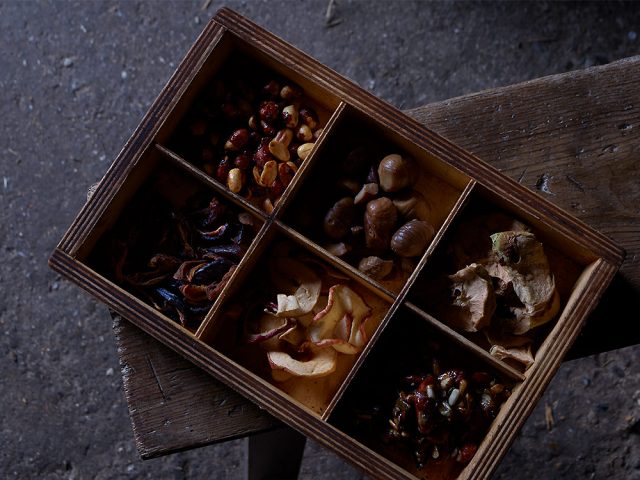
Assorted Autumn Sweets
Dehydration—the process of removing moisture and thereby preventing the growth of bacteria—is humanity’s oldest method of food preservation, dating back to prehistory. Using the sun, wind, and smoke, people have been drying fruit and seeds for thousands of years.
Preparation
Preheat the oven to 150°F (100°C).
Wash and dry your fresh fruits and/or vegetables. Remove any pits, stones, or stems. Cut and slice them evenly.
Arrange them in a single layer on a cookie sheet or oven tray so they are not overlapping. Place the tray in the oven, and turn the fruit every hour or two, until dried.
Meanwhile, heat a little neutral oil in a pan over low-medium heat. Combine with honey or maple syrup and spices, such as cinnamon, miso, chili, nutmeg, lemon zest, or sea salt. Mix in nuts or seeds. Stir until toasted, about 5 minutes. Spread them out on a large platter or baking sheet. Let cool.
To serve, assemble the ingredients neatly on a large platter, board, or tray.

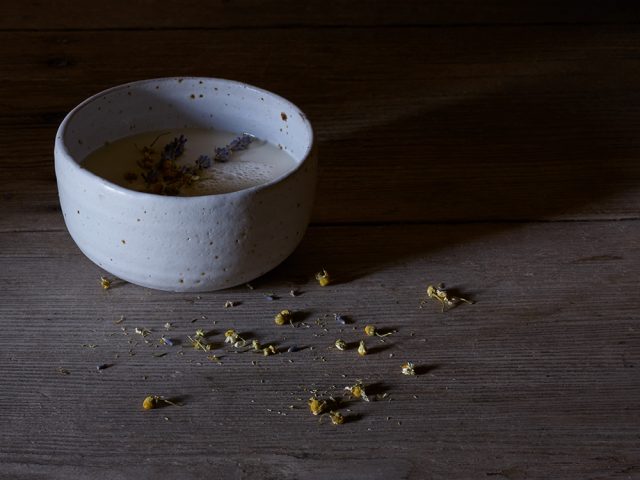
Lavender and Chamomile Milk
Drinking a glass of warm milk—like this floral after-dinner brew—is widely associated with comfort and relaxation, especially in the evening.
Ingredients
-
1 quart (1 liter) plant-based milk of your choice
-
Dried lavender and chamomile
-
Honey or plant-based syrup to taste (optional)
Preparation
This floral infusion can be prepared the night before and left to develop more intense flavors overnight. It can also be prepared on the day of your gathering.
Set aside a small amount of the dried flowers for garnish. Add the milk and remaining dried flowers to a pot and bring to just under boiling temperature before turning down to low heat.
Let the flowers steep for about an hour.
Remove from heat and cover. Leave the mixture to rest until it’s time to serve.
Before serving, strain and reheat the milk. Pour into cups and garnish with the extra dried flowers. Serve with honey or other plant-based syrup as an optional sweetener.

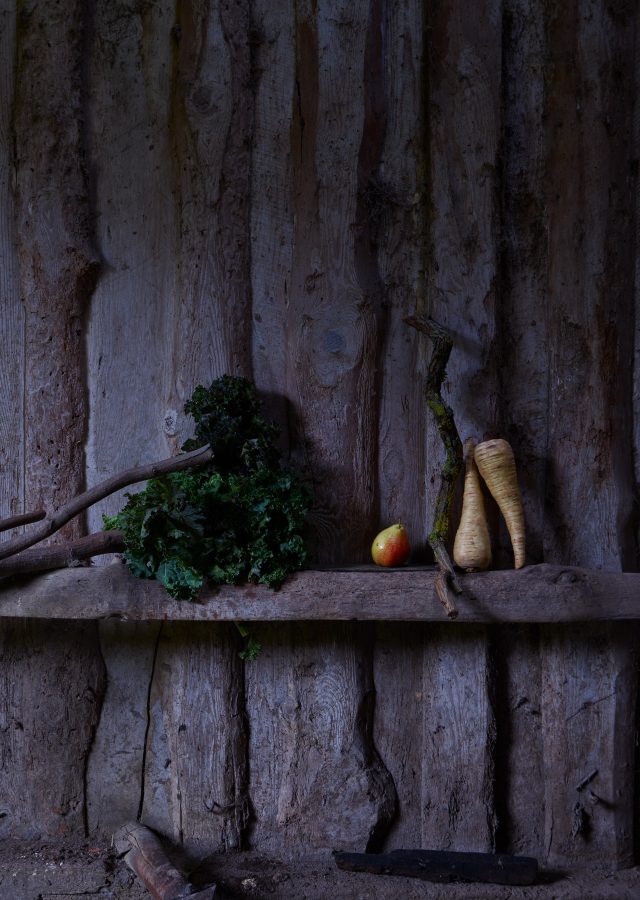
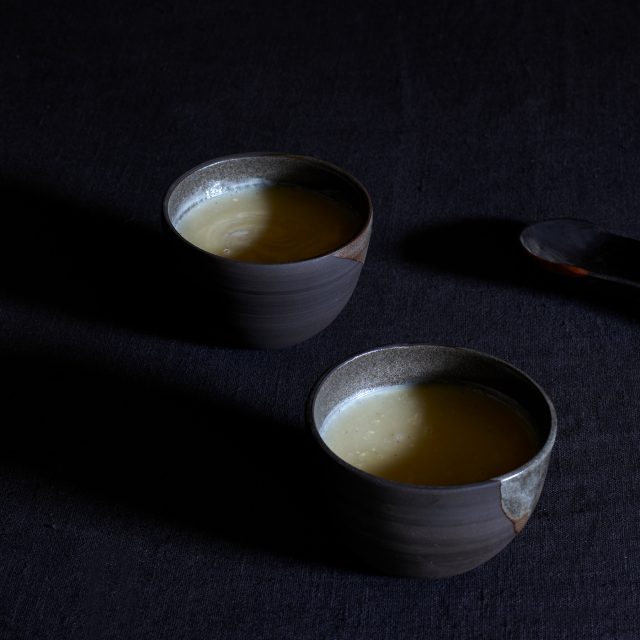
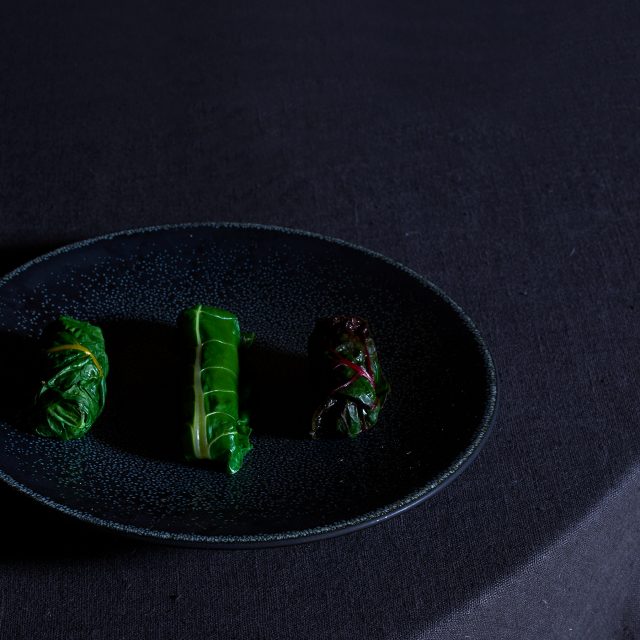

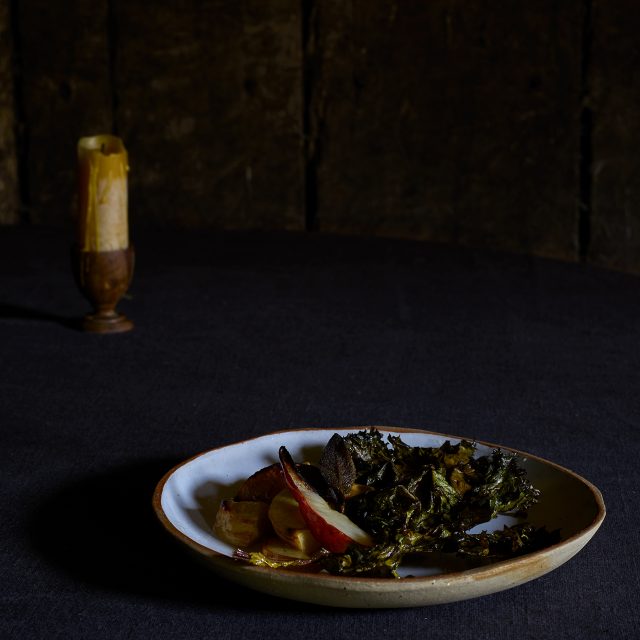

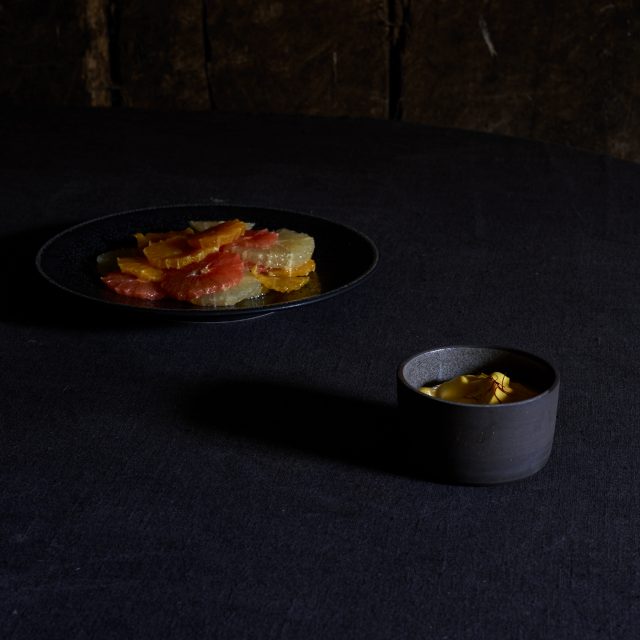
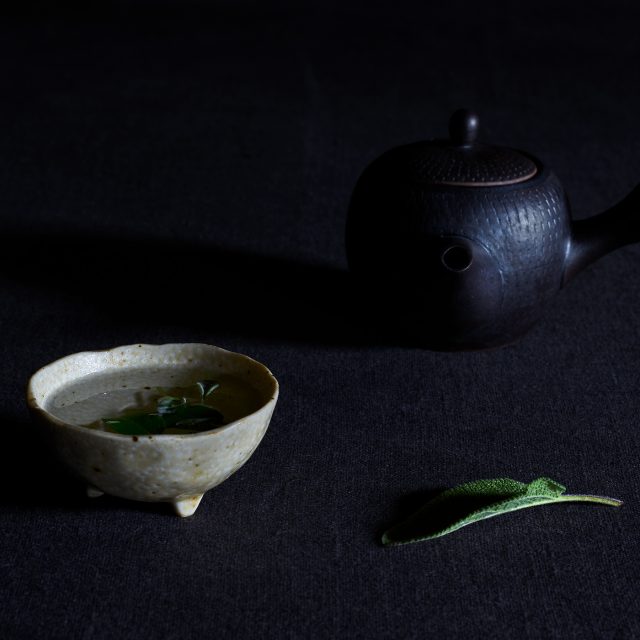
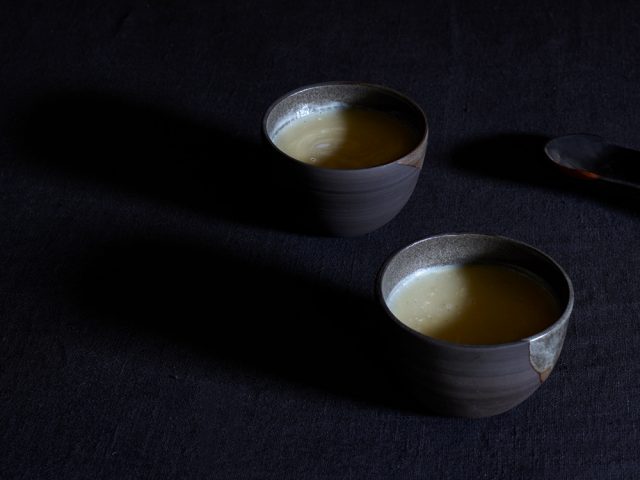
Celeriac, Potato, and Vanilla Soup
Native to Mexico, vanilla is one of 25,000 species of orchid. Widely regarded as one of the most complex spices, vanilla beans are believed to have at least 250 different compounds of flavor and aroma. Though most often associated with sweets, vanilla can be a subtle and sophisticated addition to savory dishes like this celeriac and potato soup.
Ingredients
-
1 celeriac
-
18 ounces (500 grams) potatoes
-
Olive oil
-
Sea salt
-
6½ cups (1.5 liters) light vegetable stock
-
1 vanilla pod
-
1 tablespoon sugar
-
Black pepper
-
1 cup (200 milliliters) plant-based or dairy crème fraîche, or cream
Optional Topping
-
Olive oil and roasted hazelnuts
Preparation
This soup can be prepared a day or two in advance; the flavor of the vanilla deepens over time.
Preheat the oven to 400°F (200°C). Peel the celeriac and potatoes and chop them in small chunks. Toss with olive oil and sea salt, and roast them in the oven for 20–30 minutes, until soft and golden.
In a large pot, combine 1 quart (1 liter) vegetable stock with the roasted roots and bring to a boil. Let simmer for a few minutes and blend until smooth. Add the remaining stock.
Cut the vanilla pod in half. Using the tip of a knife, scrape the seeds from the pod and grind together with a little bit of sugar using a mortar and pestle. Add vanilla, salt, pepper, and crème fraîche to taste, and a little more water if needed. Leave the scraped vanilla pods in the soup and let the soup cool down.
Store the soup in the fridge in an airtight container and reheat just before serving. Serve as-is, or with a drizzle of olive oil and toasted hazelnuts.

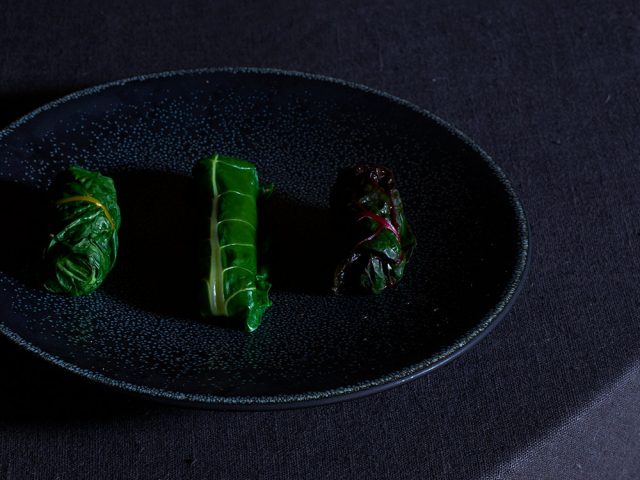
Chard Rolls with Grains and Nuts
Chard—also known as silver beet, strawberry spinach, and Roman kale—is a leafy green in the same family as beets and spinach. It is a great source of nutrients in autumn and winter, when fresh seasonal foods can be scarce.
These rolls not only offer all the nutrition of lightly steamed chard, but the brilliant color as well. Filled with hazelnuts and dates, this winter appetizer is crunchy and sweet, served with a ginger-soy dipping sauce.
Ingredients
For the rolls
-
½ cup whole grain, such as farro, barley, or quinoa
-
1 ounce (25 grams) hazelnuts
-
2–3 dates
-
½ cup dried soya mince (texturized vegetable protein)
-
7 ounces (200 grams) mushrooms
-
Oil or butter
-
Black pepper
-
2 small mixed-color carrots or beets
-
12 chard leaves or large spinach leaves
-
Soy sauce
For the dipping sauce
-
1 ounce (25 grams) hazelnuts
-
2–3 dates
-
1½–2 tablespoons soy sauce
-
¼ cup neutral oil
-
1 tablespoon grated fresh ginger
-
¼ cup water
Preparation
Cook the grains and set aside.
Toast the hazelnuts for both the rolls and the dipping sauce in a pan until golden brown, and then chop into rough pieces. Deseed the dates and chop finely. Combine with the hazelnuts. Divide in two bowls, one for the rolls and one for the dipping sauce.
Make the dipping sauce by blending the hazelnuts, dates, soy sauce, oil, and ginger until smooth. Add water, little by little, until the texture is creamy.
Soak the soya mince in hot water for 10 minutes. Drain and squeeze out any excess water.
Clean and trim the mushrooms and cut them in irregular, small pieces.
Heat a skillet with oil or butter and add the mushrooms. Cook until they start to release water. Add the soy mince, soy sauce, and black pepper. Cook for another 5 minutes, stirring occasionally.
Wash the carrots and cut them into very thin strips, about 3 inches (7–8 centimeters) long.
Wash and trim the chard or spinach leaves, keeping them whole. In a large pot or pan, bring water to a boil and cook the leaves, a few at a time, for about 1–4 minutes until the stems are soft. Let them dry on a tea towel.
Spread out one leaf at a time on a large board or platter, and add a small amount of grains, mushroom mince, carrot sticks, dates, and nuts to the middle of the leaf. Fold in the sides first, and then roll.
If you want, you can steam the rolls lightly in a steaming pot or basket right before serving.


Simmered Tofu with Seaweed and Radishes
Seaweed broth is as much a staple in Japan as chicken broth is in the United States. Kombu creates a simple and delicate vegetarian broth, full of umami flavor. This dish is both refreshing and hearty, full of antioxidants, minerals, and healthy fats.
Ingredients
-
A piece of kombu or local kelp/seaweed variety
-
25 ounces (700 grams) silken tofu
-
Spring onions
-
A few radishes or 1 turnip
-
Soy sauce or ponzu
Preparation
Add 1 quart (1 liter) of water to a pot and bring to a boil. Reduce the temperature, and add the kombu piece to the water. Let simmer, but not boil, for 20 minutes. Remove the kombu, but save the water for the tofu.
Cut the tofu in large cubes and add it to the water. Cover and let simmer for 5 minutes.
Serve the tofu and broth in a large ceramic bowl or pot, and let your guests help themselves, or assemble on individual plates right before serving.
Garnish with thinly sliced spring onion and finely grated radishes or turnips. Serve with soy sauce or ponzu on the side.

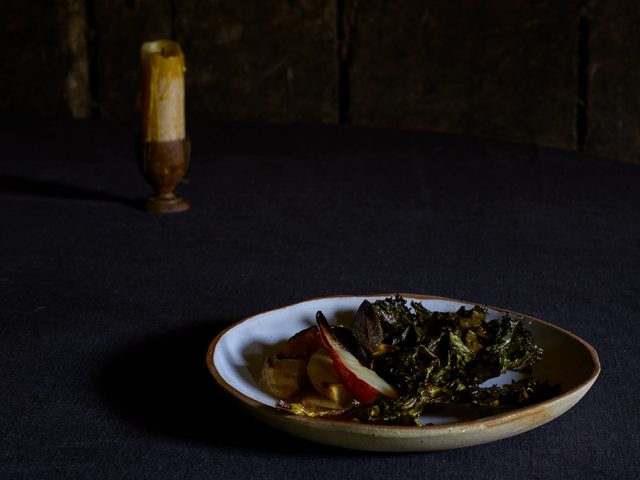
Roasted Parsnips, Pear, and Kale
Orchards have long been a fixture on monastery grounds, providing a reliable abundance of fruit to convent communities. As monks and nuns developed knowledge of pruning, grafting, and creating new varieties of fruit, monasteries became sources of local orchard expertise.
When roasted, pears add a soft and sweet element to the strong flavor of parsnip and the light crisp of kale.
Ingredients
For the roast
-
9 ounces (250 grams) cavolo nero, curly kale, or other kale
-
Olive oil
-
Sea salt flakes
-
18 ounces (500 grams) parsnips
-
2–3 pears
For the dressing
-
¼ cup olive oil
-
½ lemon
-
1–2 teaspoons Dijon mustard
-
1–2 teaspoons honey
-
Sea salt flakes
-
Black pepper
Preparation
Prepare the roast
Preheat the oven to 300°F (150°C).
Wash the kale and spread it out on tea towels to dry. Keep the leaves whole but remove the thick and rough stems (these can be chopped and used for other cooking). Place the kale in a single layer on an oven tray. Massage olive oil and sea salt flakes into the kale, making sure all is covered.
Bake for around 15–20 minutes, stirring every now and then. The kale should be crisp but not burnt.
Increase the oven temperature to 400°F (200°C).
Clean, brush, and chop the parsnips in large, irregular chunks or sticks. Clean and deseed the pears, leaving the peel on, and cut them into wedges. Toss the parsnip and pear with olive oil and spread out on an oven tray. Season with sea salt flakes and roast for 20 minutes. Increase the temperature a little and roast for another 5–10 minutes until all is crisp and golden.
Prepare the dressing
Whisk together olive oil, lemon juice, Dijon mustard, honey, salt, and pepper.
To serve
Arrange warm parsnips and pears with the crispy kale on a tray or large platter. Drizzle with lemon dressing.

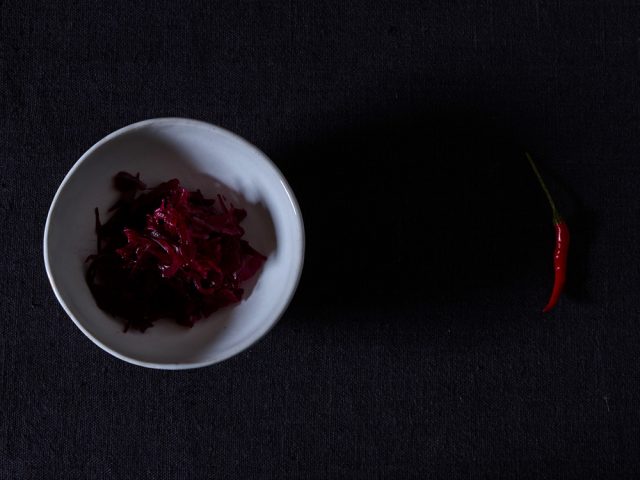
Ruby Kraut with Chili
Fermentation developed as a technique to preserve vegetables and fruits for winter or other times of scarcity, when vitamins and nutrients are difficult to come by. The process of fermentation builds layers of flavor over time. In Korean temple cuisine, Buddhist monks do not eat garlic, onions, chives, green onions, or leeks, because they believe them to hinder spiritual practice. Instead, fermented foods are used to add sharp and complex flavor to meals.
Ingredients
-
1 small-to-medium-sized red cabbage
-
2 beets
-
1–2 tablespoons fine sea salt or Himalayan salt
-
1–2 fresh chilies
Preparation
Clean the red cabbage and set aside one large leaf. Peel the beets.
Shred the cabbage finely, and cut the beets into long, very thin strips, or use a grater. Layer cabbage, beets, and sea salt in a large mixing bowl. Pressing with your hands, massage the cabbage until it begins to release water. The taste should be slightly saltier than you want the final kraut to be.
Slice the chili, keeping the seeds if you want the kraut to be spicy, and add the slices to the bowl.
Little by little, place the cabbage mixture into a large, clean glass jar or ceramic vessel, pressing it down to make sure there are no air bubbles. The cabbage should be covered by liquid. If it is not, you can make a brine with 1 tablespoon (15 grams) of sea salt per quart (liter) of water and fill up the jar with it. Leave about an inch free and place the cabbage leaf on top.
Before closing the lid, weigh down the cabbage to ensure that it stays covered in liquid throughout the fermentation process (being fully submerged in the brine prevents the growth of bacteria). To do this, you can use the core of the cabbage, a smaller glass jar that’s been sterilized, or the circular core of an apple. Do not use stones or any household objects.
Close the lid and leave the jar in a dark place at room temperature (but not too warm) for 1–3 days. Open the jar for a couple of minutes once a day to let it breathe.
When bubbles have formed, the fermentation process has started. Transfer the jar to a cooler place, such as a basement. You no longer need to let it breathe daily, but check your kraut every now and then, making sure there is no mold growing and that it is still covered by liquid. If needed, add some cold brine.
After 10–14 days, transfer the jar to the fridge. It is now ready to eat, but you can wait a week or two for the flavors to develop further. Once you open the jar, the kraut will keep for a month. Unopened, it will keep for 6 months or more.


Winter Fruits with Saffron-Tofu Cream
Saffron is made from the dried stigmas of Crocus sativas, a flower that is dependent on humans for its reproduction and continued survival. Saffron has long been treasured for its unique flavor and rich color. Monks in the Middle Ages mixed saffron with egg white to create a yellow glaze for illuminated manuscripts, in place of gold. Only a small pinch of saffron is needed to add a warm orange coloring and full-bodied flavor—both rich and delicate—to this winter dessert.
Ingredients
-
¼ cup raisins or sultanas
-
½ gram saffron, the best quality you can afford
-
1 teaspoon sugar
-
25 ounces (700 grams) silken tofu (or substitute with yogurt or quark)
-
¼ cup honey, or to taste
-
½ lemon
-
Mixed winter fruits, such as citrus and persimmon
Preparation
Soak the raisins or sultanas in warm water until softened.
Using a mortar and pestle, grind the saffron with a pinch of sugar.
Drain the tofu and wrap it in a clean tea towel. Let it dry for at least 15 minutes to remove excess liquid.
Add the tofu and saffron sugar to a bowl, and combine using a stick blender (you can also use a food processor). Blend until completely smooth. Add honey and a little bit of lemon juice to taste. Drain the raisins and combine them with the tofu mixture. Chill for at least an hour, or overnight.
If you prefer, you can replace the tofu with organic yogurt or quark—simply mix it with the saffron-sugar, honey, and raisins.
Before serving, peel and slice wintry fruits of your choice—oranges and grapefruit are good options—and arrange them on a platter or in a bowl. Serve with the saffron cream.

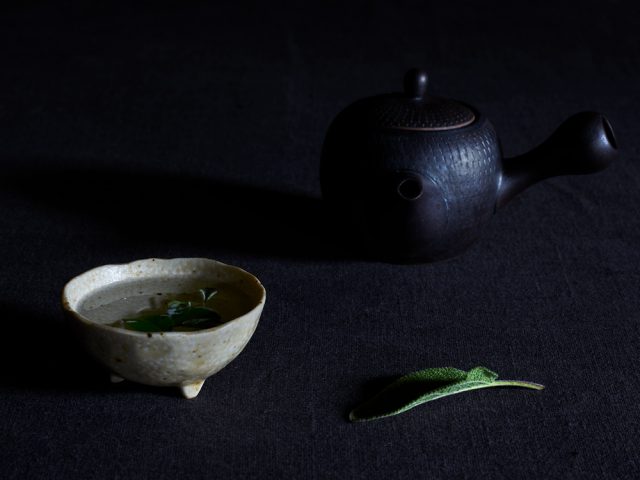
Sage Tea
For thousands of years, rituals, ceremonies, and expectations of etiquette have developed around the simplest of acts: drinking a cup of tea.
Some of these ceremonies are deeply symbolic and complex. The traditional Japanese tea ceremony, for example, is a ritual of serving green tea, or matcha. It incorporates the body, heart, and spirit, and includes a series of outer actions that mirror an inner process of transformation.
Some tea ceremonies are exceedingly simple. Drinking a cup of tea is an ancient, ongoing, and cross-cultural way of welcoming a guest, showing hospitality, or just enjoying a quiet moment after a meal.
Ingredients
-
Fresh or dried whole sage leaves
Preparation
Add sage leaves to individual cups or small bowls, and fill with nearly-boiling water. Let the tea steep for a few minutes before serving.

